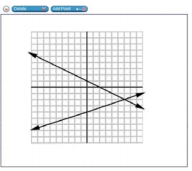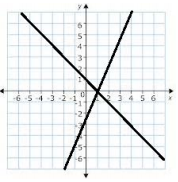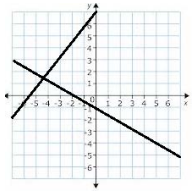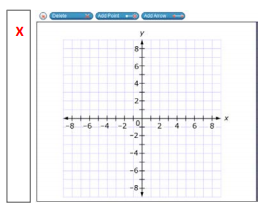- Understand that solutions to a system of two linear equations in two variables correspond to points of intersection of their graphs, because points of intersection satisfy both equations simultaneously.
- Solve systems of two linear equations in two variables algebraically, and estimate solutions by graphing the equations. Solve simple cases by inspection. For example, 3x + 2y = 5 and 3x + 2y = 6 have no solution because 3x + 2y cannot simultaneously be 5 and 6.
- Solve real-world and mathematical problems leading to two linear equations in two variables. For example, given coordinates for two pairs of points, determine whether the line through the first pair of points intersects the line through the second pair.
Remarks
Examples of Opportunities for In-Depth FocusWhen students work toward meeting this standard, they build on what they know about two-variable linear equations, and they enlarge the varieties of real-world and mathematical problems they can solve.
Clusters should not be sorted from Major to Supporting and then taught in that order. To do so would strip the coherence of the mathematical ideas and miss the opportunity to enhance the major work of the grade with the supporting clusters.
- Assessment Limits :
Numbers in items must be rational numbers. Coefficients of equations in standard form must be integers. Items written for MAFS.8.EE.3.8a must include the graph or the equations. Equations in items written for MAFS.8.EE.3.8a must be given in slope-intercept form. - Calculator :
Yes
- Context :
Allowable
- Test Item #: Sample Item 1
- Question: A graph of a system of two equations is shown.
Use the Add Point tool to plot the solution of the system.

- Difficulty: N/A
- Type: GRID: Graphic Response Item Display
- Test Item #: Sample Item 2
- Question:
Analyze the system of two equations shown.
y=3(x+4)
y=3(x-4)
How many solutions does the system of equations have?
- Difficulty: N/A
- Type: SHT: Selectable Hot Text
- Test Item #: Sample Item 3
- Question:
A graph of a system of two equations is shown.

What is the solution of the system?
- Difficulty: N/A
- Type: EE: Equation Editor
- Test Item #: Sample Item 4
- Question:
A graph of a system of two equations is shown.

What is the approximate solution of the system?
- Difficulty: N/A
- Type: EE: Equation Editor
- Test Item #: Sample Item 5
- Question:
A system of two equations is shown.
y = 5x + 3
y = 3x - 1
A. Use the Add Arrow tool to graph the two lines.
B. Drag the palette image to show the solution of the system.

- Difficulty: N/A
- Type: GRID: Graphic Response Item Display
- Test Item #: Sample Item 6
- Question: Radha is trying to choose between two bike rental companies, Company A and
Company B.
Company A charges a $25 initial fee and an additional $5 for each hour rented. Company B charges an initial $18 fee and an additional $6 for each hour rented.
The total cost to rent a bike from Company A can be represented by the equation y=5h+25, where h represents the number of hours rented and y represents the cost, in dollars.
The total cost to rent a bike from Company B can be represented by the equation y=6h+18, where h represents the number of hours rented and y represents the cost, in dollars.
For how many hours of rental is the amount charged by the two companies the same? What is the cost, in dollars, of renting the bike for this many hours?
- Difficulty: N/A
- Type: EE: Equation Editor
- Test Item #: Sample Item 7
- Question: Enter values for ?? and ??, so that the system of equations shown has one solution.
y = 3x + 4
y = ax + b
- Difficulty: N/A
- Type: EE: Equation Editor
- Test Item #: Sample Item 8
- Question:
Select the number of solutions for each system of two linear equations.
- Difficulty: N/A
- Type: MI: Matching Item
Related Courses
Related Access Points
Related Resources
Educational Software / Tool
Formative Assessments
Lesson Plans
Problem-Solving Tasks
Student Center Activity
Tutorials
MFAS Formative Assessments
Students are asked to determine the number of solutions of each of four systems of linear equations without solving the systems of equations.
Students are asked to identify the solutions of systems of equations from their graphs and justify their answers.
Students are asked to solve a system of linear equations by graphing.
Students are asked to solve three systems of linear equations algebraically.
Students are asked to solve a word problem by solving a system of linear equations.
Students are given word problems and asked to write a pair of simultaneous linear equations that could be used to solve them.
Student Resources
Problem-Solving Tasks
The purpose of this task is to help students learn to read information about a function from its graph, by asking them to show the part of the graph that exhibits a certain property of the function. The task could be used to further instruction on understanding functions or as an assessment tool, with the caveat that it requires some amount of creativity to decide how to best illustrate some of the statements.
Type: Problem-Solving Task
This task asks students to find the amount of two ingredients in a pasta blend. The task provides all the information necessary to solve the problem by setting up two linear equations in two unknowns. This progression of tasks helps distinguish between 8th grade and high school expectations related to systems of linear equations.
Type: Problem-Solving Task
This task presents a real-world problem requiring the students to write linear equations to model different cell phone plans. Looking at the graphs of the lines in the context of the cell phone plans allows the students to connect the meaning of the intersection points of two lines with the simultaneous solution of two linear equations. The students are required to find the solution algebraically to complete the task.
Type: Problem-Solving Task
In this task, we are given the graph of two lines including the coordinates of the intersection point and the coordinates of the two vertical intercepts and are asked for the corresponding equations of the lines. It is a very straightforward task that connects graphs and equations and solutions and intersection points.
Type: Problem-Solving Task
The task is a modeling problem which ties in to financial decisions faced routinely by businesses, namely the balance between maintaining inventory and raising short-term capital for investment or re-investment in developing the business.
Type: Problem-Solving Task
Students are asked to create and graph linear equations to compare the savings of two individuals. The purpose of the table in (a) is to help students complete (b) by noticing regularity in the repeated reasoning required to complete the table.
Type: Problem-Solving Task
Students are asked to write equations to model the repair costs of three different companies and determine the conditions for which each company would be least expensive. This task can be used to both assess student understanding of systems of linear equations or to promote discussion and student thinking that would allow for a stronger solidification of these concepts. The solution can be determined in multiple ways, including either a graphical or algebraic approach.
Type: Problem-Solving Task
The student is given the equation 5x-2y=3 and asked, if possible, to write a second linear equation creating systems resulting in one, two, infinite, and no solutions.
Type: Problem-Solving Task
Student Center Activity
Students can practice answering mathematics questions on a variety of topics. With an account, students can save their work and send it to their teacher when complete.
Type: Student Center Activity
Tutorials
This example demonstrates solving a system of equations algebraically and graphically.
Type: Tutorial
This video demonstrates a system of equations with no solution.
Type: Tutorial
This video shows how to solve a system of equations using the substitution method.
Type: Tutorial
This video demonstrates testing a solution (coordinate pair) for a system of equations
Type: Tutorial
This video demonstrates analyzing solutions to linear systems using a graph.
Type: Tutorial
This video shows how to algebraically analyze a system that has no solutions.
Type: Tutorial
When solving a system of linear equations in x and y with a single solution, we get a unique pair of values for x and y. But what happens when try to solve a system with no solutions or an infinite number of solutions?
Type: Tutorial
Parent Resources
Problem-Solving Tasks
The purpose of this task is to help students learn to read information about a function from its graph, by asking them to show the part of the graph that exhibits a certain property of the function. The task could be used to further instruction on understanding functions or as an assessment tool, with the caveat that it requires some amount of creativity to decide how to best illustrate some of the statements.
Type: Problem-Solving Task
This task asks students to find the amount of two ingredients in a pasta blend. The task provides all the information necessary to solve the problem by setting up two linear equations in two unknowns. This progression of tasks helps distinguish between 8th grade and high school expectations related to systems of linear equations.
Type: Problem-Solving Task
This task presents a real-world problem requiring the students to write linear equations to model different cell phone plans. Looking at the graphs of the lines in the context of the cell phone plans allows the students to connect the meaning of the intersection points of two lines with the simultaneous solution of two linear equations. The students are required to find the solution algebraically to complete the task.
Type: Problem-Solving Task
In this task, we are given the graph of two lines including the coordinates of the intersection point and the coordinates of the two vertical intercepts and are asked for the corresponding equations of the lines. It is a very straightforward task that connects graphs and equations and solutions and intersection points.
Type: Problem-Solving Task
The task is a modeling problem which ties in to financial decisions faced routinely by businesses, namely the balance between maintaining inventory and raising short-term capital for investment or re-investment in developing the business.
Type: Problem-Solving Task
Students are asked to create and graph linear equations to compare the savings of two individuals. The purpose of the table in (a) is to help students complete (b) by noticing regularity in the repeated reasoning required to complete the table.
Type: Problem-Solving Task
Students are asked to write equations to model the repair costs of three different companies and determine the conditions for which each company would be least expensive. This task can be used to both assess student understanding of systems of linear equations or to promote discussion and student thinking that would allow for a stronger solidification of these concepts. The solution can be determined in multiple ways, including either a graphical or algebraic approach.
Type: Problem-Solving Task
The student is given the equation 5x-2y=3 and asked, if possible, to write a second linear equation creating systems resulting in one, two, infinite, and no solutions.
Type: Problem-Solving Task









